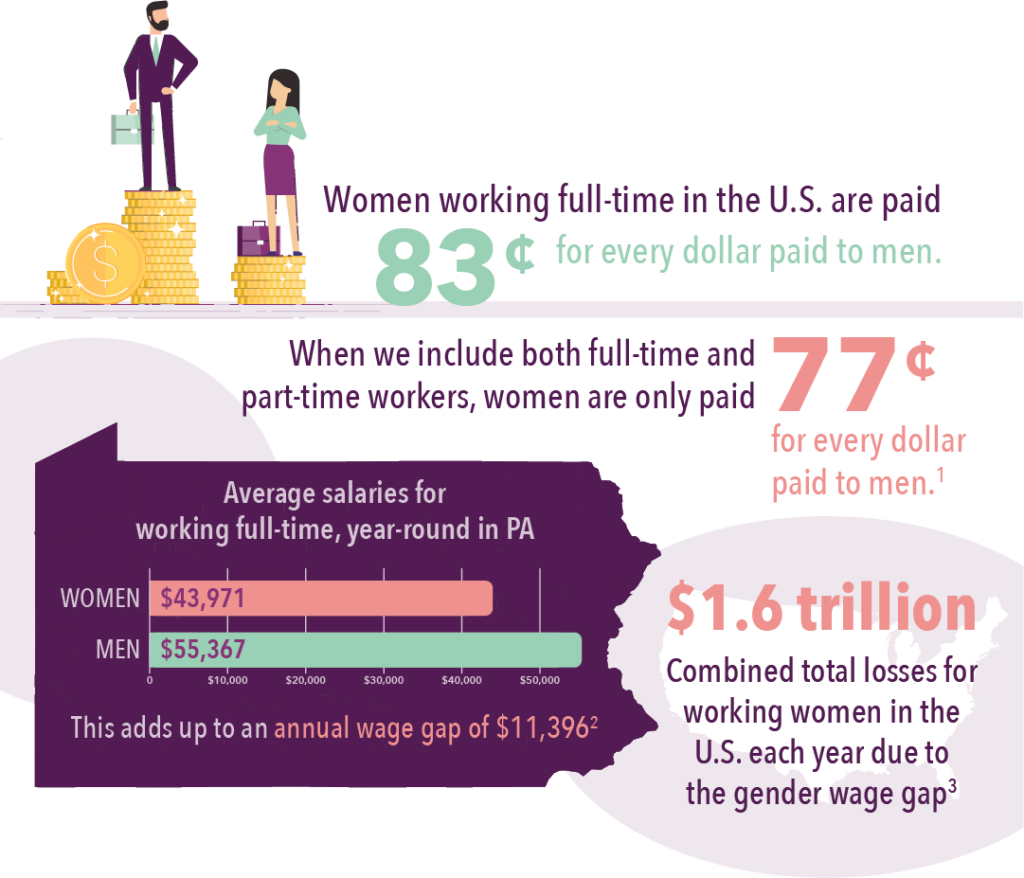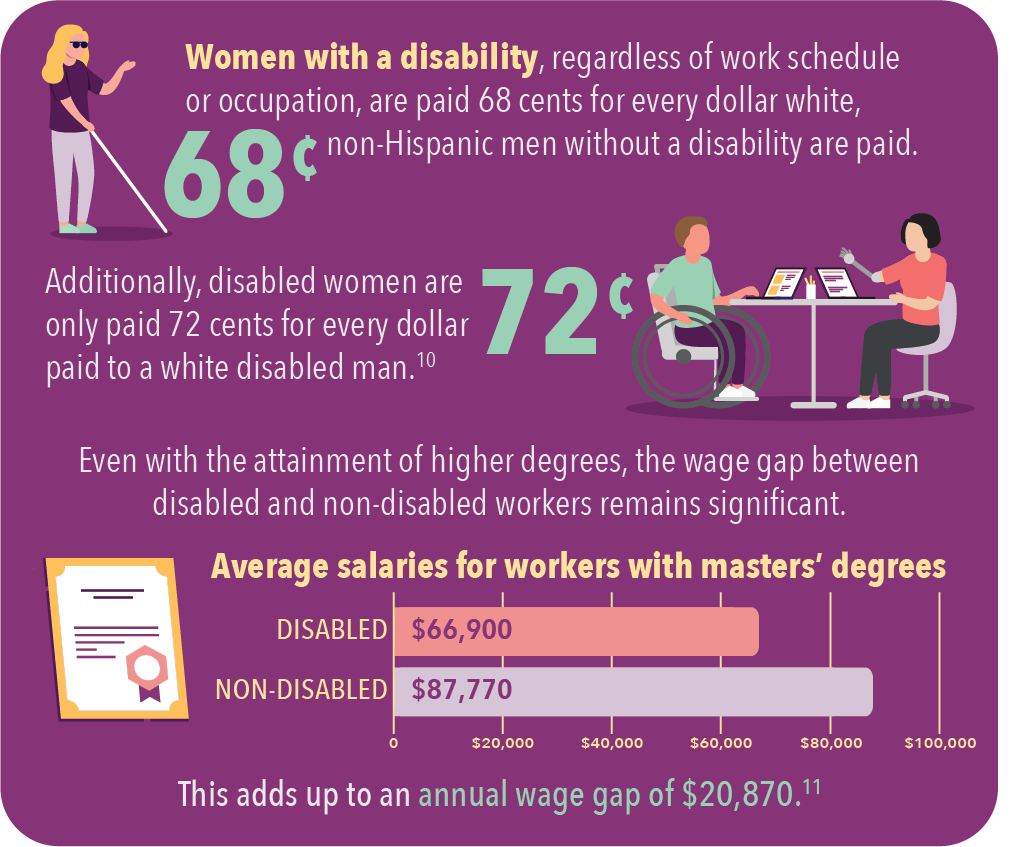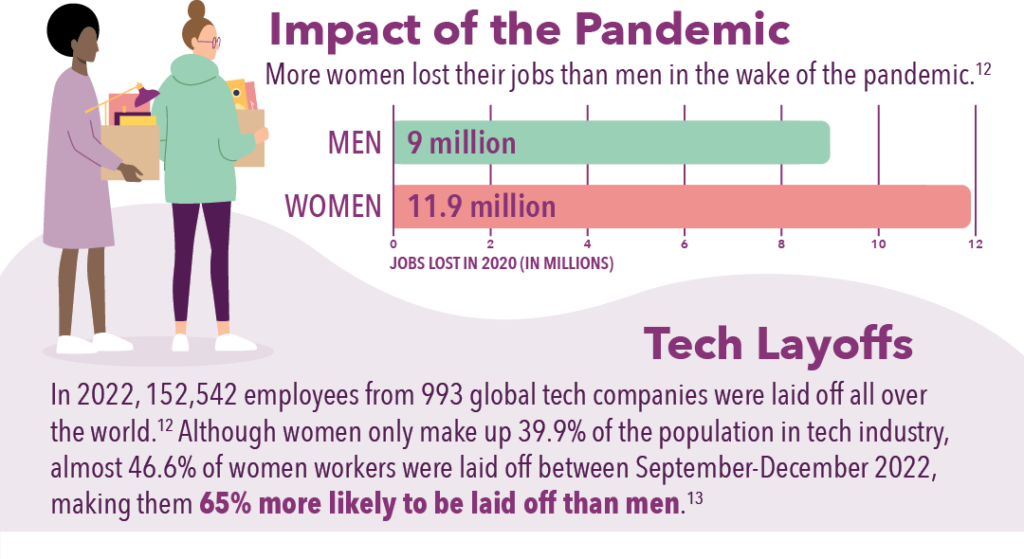
Why does the gender wage gap matter?
The gender wage gap negatively impacts women’s economic well-being and their health.
These impacts affect domestic violence in two ways:
- It increases the likelihood that women will experience risk factors for domestic violence
- It creates barriers for victims and survivors trying to leave and recover from abusive relationships
The wage gap is a systemic issue, not a result of individual choices.



The work women do is valued less than men, and discrimination against women in the workplace can affect how, or if, they advance in their careers.
The wage gap is worse for women of color and women with disabilities.
We cannot address the gender wage gap without addressing racism.

Racism and other systemic oppressions have women of color on the path to not see wage equity for another one to two hundred-plus years.


Recent layoffs disproportionately impacted women, especially women of color and other under-represented populations.


When fired from their jobs, women may have additional factors to consider—like the cost of childcare, maternity leave, and flexible/hybrid work schedules—limiting their options when applying for a new job.
Women of color have the added stress of not knowing how diverse, inclusive, and welcoming a new job environment might be.
How can YOU help close the gender wage gap?
There are action steps that both individuals and organizations can take to narrow the wage gap.
What individuals can do:
- Connect with your Pennsylvania local domestic violence program to support survivors and their economic needs. Find your local Pennsylvania program here.
- Take available finance and salary negotiation courses. For example: AAUW’s online salary negotiation course to learn how to advocate for better benefits and pay.
- Visit your state’s labor law compliance website if you think you are experiencing pay discrimination. In Pennsylvania, that can be found here. You can also visit general steps, here, on page 25.
What organizations can do:
- Connect with your Pennsylvania local domestic violence program for connecting to employees who may or may know someone experiencing domestic violence.
- Provide sick and safe leave to all employees, preferably paid.
- Provide paid parental leave, to mothers and fathers.
- Offer flexible work scheduling to all employees.
- Bring change to your hiring practices. These include:
- Banning the use of salary history.
- Publish wage or salary ranges on job postings.
- Prohibit retaliation for wage disclosure.
- Learn about, and implement equitable recruitment, hiring and promotion practices.
- Review your job descriptions and template language for unnecessary requirements.
- Conduct a pay audit of your organization or company and continue to do so regularly.
- Provide a thriving wage to all your employees.
- Implement diversity, equity, and inclusion (DEI) practices.
Endnotes:
- National Partnership for Women & Families (2022). Americas women and the wage gap.
- United States Census Bureau (2022). What is the Gender Wage Gap in your State?
- National Partnership for Women & Families (2022). Americas women and the wage gap.
- Kochhar, Rakesh. “Hispanic women, immigrants, young adults, those with less education hit hardest by COVID-19 job losses.” Pew Research Center (2020).
- Patrick, K, (2017). Low-Wage Workers are Women: Three Truths and a Few Misconceptions.” National Women’s Law Center.
- Elise Gould, Jessica Schieder, and Kathleen Geier. "What is the gender pay gap and is it real?" From Economic Policy Institute (2016).
- Institute for Women’s Policy Research (2022). The wage gap for Mothers by State.
- Institute for Women’s Policy Research (2022). Annual Gender Wage Gap by Race and Ethnicity 2022.
- Institute for Women's Policy Research's report – The impact of equal pay on poverty.
- Moss, H. (2022). Wage Disparities & the Rippling Effect on Women with Disabilities.
- Weil, E. (2022). Does a College Degree Close the Disability Wage Gap?
- Trueman, C. (2023). How layoffs can affect diversity in tech—and what to do about it.
- Economic Times (2023). Big tech layoffs may further disrupt equity and diversity efforts.
- Elliott, V. (2022). Tech Industry Layoffs May Undo Workforce Diversity Gains. Wired.
- Trueman, C. (2023). How layoffs can affect diversity in tech—and what to do about it.
- Trueman, C. (2023). How layoffs can affect diversity in tech—and what to do about it.
- American Association of University Women (2021). Systemic Racism and the Gender Pay Gap.